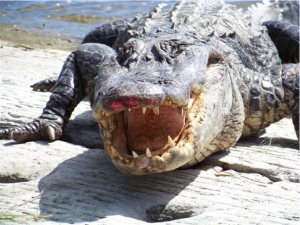In an annual nighttime survey in September of the alligator population at Marine Corps Air Station
New River and Camp Lejeune, N.C., environmental officials spotted 26 American alligators roaming near New River.
Gator glossary
+ An alligator’s size is relative to the length of its growing season when it has access to food. Therefore, a 10-feet long alligator in Florida may actually be younger than a 10-feet long alligator in North Carolina.
+The animal’s size can be estimated by measuring the distance from its snout to its eyes. Whatever that measurement is in inches, the alligator’s entire body is approximately that long in feet.
+Most alligators in North Carolina won’t get larger than 10-feet, but a 19 foot alligator was recorded in Louisiana in 1890.
+The longest an alligator lived was 47 years in captivity. Most can live up to 50 years old, but it’s hard to monitor age in the wild.
+Alligators are carnivores and will eat just about anything they can fit in their mouths, that can be turtles, snakes, bird, fish and small mammals.
+Feeding alligators is against the law in North Carolina because the more alligators associate humans with food the more of a threat they become.
+As long as people give alligators enough room, the animals should not be dangerous.
+Alligators can travel relatively far between water sources. The North Carolina Wildlife Resource Commission sees alligators up to a quarter-mile from water.
+Males can weigh twice as much as females. Males can weigh up to 350 pounds and females can weigh up to 112 pounds.
+The American Alligator is the country’s largest native reptile.
+Alligators are distinct from crocodiles because of their teeth and snout. An alligator’s snout is much rounder and their teeth fit inside the mouth
Information according to Jeff Hall, biologist with the North Carolina Wildlife Resource Commission in Greenville.
That’s not out of line with the number of alligators experts would expect in the area. However, humans and gators increasingly are living closer together.
For example, Lejeune’s wildlife team recently relocated an 8-foot, 3-inch alligator to French Creek. It had been trapped inside a fenced compound at a construction site. And environmental officials at New River had to relocate an alligator that was living in a storm-water pond next to the barracks.
The population has remained relatively consistent with previous years and stable and healthy, said Martin Korenek, wildlife manager at Camp Lejeune. The base, which monitors wildlife populations throughout the year, typically reports eight to 15 alligators of various sizes.
Animals found during the survey ranged from a foot to 12 feet long, said Merrick Reid, an environmental specialist at New River. Surveyors looked at the area of Southwest Creek south of “Alligator Bridge” at the station.
“Alligators can be found in many, if not all, of the creeks and tributaries of the New River,” Reid said. “Additionally they can be found from time to time in the many storm-water ponds located aboard the installation.”
Most importantly, Reid said, people must remember that feeding wild alligators is illegal in North Carolina. If the gators lose their fear of humans, they are more likely to approach people and show aggressive behavior, Reid added.
The survey, a snapshot of the alligator population, has been completed every fall for more than 20 years, Reid said, and is part of the larger Camp Lejeune Wildlife Management program.
Jeff Hall, a biologist with the North Carolina Wildlife Resource Commission, said that while some people say there are more encounters with alligators, it might just be because more people are living closer to the alligators’ natural habitat and simply running into the animals more often.
If personnel or visiting family members see an alligator or any other threatening animal, they should avoid any contact and call 911 or the Installation Conservation Law Enforcement officers directly at 910-449-4776.

